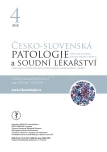-
Medical journals
- Career
Blood is thicker than water: Physical limitations of bloodstain pattern analysis
Authors: Šrámek Jaromír
Authors‘ workplace: Ústav histologie a embryologie, 1. lékařská fakulta Univerzity Karlovy, Praha
Published in: Soud Lék., 63, 2018, No. 4, p. 34-38
Category: Review
Overview
Scientific bloodstain pattern analysis was appeared at the end of the 19th century in Kraków. Nowadays, bloodstain pattern analysis is the forensic science involving analysis of blood traces on the crime scene. One topic is an estimation of the point of origin of given blood spatter. The processes behind the formation of the blood spatter are quite complicated, some simplifications are necessary. For example, the true trajectory of the blood drop is rather the ballistic curve than the line, though the line is often used as a sufficient model of the trajectory. Next, the blood is a non-Newtonian complex fluid, it differs from common fluids like water. Moreover, qualities of the surface are also involved in the formation of the final spatter. Some of these properties of blood must be neglected in order to make the modeling of the formation of the spatter possible. The crucial question is how to determine the angle of impact of the blood drop. The widely used method is the ellipse fitting method which is based on the assumption that the blood drop is ball-shaped and the spatter is chiefly the ellipse-shaped imprint of the falling drop. Other methods are using rather in experiments than in practice. Unfortunately, all these simplifications lead to the increasing uncertainty and, therefore, the point of origin is rather estimated than determined. Selection of an appropriate model of the behavior of the blood drop and estimation of uncertainty of obtained results should be based on related knowledge close to the physics of blood.
Keywords:
bloodstain pattern analysis – biomechanics
Sources
-
James SH, Kish PE, Sutton TP. Bloodtain Pattern Analysis: Theory and Practice. Boca Raton: CRC Press; 2005.
-
MacDonell HL. Credit where it‘s due. J Forensic Ident 2011; 61(3): 210-221.
-
Makovický P, Matlach R, Pokorná O, Mošna F, Makovický P. Analýza krevních stříkanců na příkladech z praxe: Jsou výpočty po aplikaci parabolické trajektorie využitelné? Soud Lek 2015; 60(4): 57-66.
-
Kvasnica J. Mechanika (2nd ed). Praha: Academia; 2004.
-
Merrill EW. Rheology of blood. Physiol Rev 1969; 49(4): 863-888.
-
Svoboda E, Kekule R. Molekulová fyzika. Praha: Academia; 1992.
-
Baskurt OK, Meiselman HJ. Blood rheology and hemodynamics. Semin Thromb Hemost 2003; 29(5): 435-450.
-
Bou Zeid W, Brutin D. Influence of relative humidity on spreading, pattern formation and adhesion of drying drop of whole blood. Coll Surf A: Physicochem Eng Aspects 2013; 430 : 1-7.
-
Kratochvíl A, Hrnčíř E. Correlation between the blood surface tension and the activity of some enzymes. Physiol Res 2001; 50 : 433-437.
-
Moyers-Gonzales M, Owens RG, Fang J. A non-homogeneous constitutive model for human blood. Part 1. Model derivation and steady flow. J Fluid Mech 2008; 617 : 327-354.
-
Carter AL. The directional analysis of bloodstain patterns theory and experimental validation. Can Soc Forens Sci J 2001; 34(4): 173-189.
-
Illes M, Boué M. Robust estimation for area of origin in bloodstain pattern analysis via directional analysis. Forensic Sci Intern 2013; 226(1-3): 223-229.
-
Kabaliuk N, Jermy MC, Williams E, Laber TL, Taylor MC. Experimental validation of numerical model for predicting the trajectory of blood drops in typical crime scene conditions, including droplet deformation and breakup, with a study of the effect of indoor air currents and wind on typical spatter drop trajectories. Forensic Sci Intern 2014; 245 : 107-120.
-
Attinger D, Moore C, Donaldson A, Jafari A, Stone HA. Fluid dynamics topics in bloodstain pattern analysis: Comparative review and research opportunities. Forensic Sci Intern 2013; 231(1-3): 375-396.
-
de Bruin KG, Stoel RD, Limborgh JCM. Improving the point of origin determination in bloodstain pattern analysis. J Forensic Sci 2011; 56(6): 1476-1482.
-
Yarin AL. Drop impact dynamics: Splashing, spreading, receding, bouncing... Annu Rev Fluid Mech 2006; 38 : 159-192.
-
Guido S. Shear-induced droplet deformation: Effects of confined geometry and viscoelasticity. Curr Opin Colloid Interface Sci 2011; 16(1): 61-70.
-
Kusumaatmaja H, Vrancken RJ, Bastiaansen CWM, Yeomans JM. Anisotropic drop morphologies on corrugated surfaces. Langmuir 2004; 24(14): 72999-7303.
-
Yeong YH, Burton J, Loth E, Bayer IS. Drop impact and rebound dynamics on an inclined superhydrophobic surface. Langmuir 2014; 30(40): 12027-12038.
-
Šikalo Š, Ganić EN. Phenomena of droplet-surface interactions. Exp Therm Fluid Sci 2006; 31(2): 97-110.
-
Grishaev V, Iorio CS, Dubois F, Amirfazli A. Complex drop impact morphology. Langmuir 2015; 31(36): 9833-9844.
-
Adam CD. Fundamental studies of bloodstain formation and characteristics. Forensic Sci Intern 2012; 219(1-3): 76-87.
-
Camana F. Determining the area of convergence in bloodstain pattern analysis: A probabilistic approach. Forensic Sci Intern 2013; 231(1-3): 131-136.
-
Joris P, Develter W, Jenar E, et al. Calculation of bloodstain impact angles using Active Bloodstain Shape Model. J Forensic Radiol Imaging 2014; 2(4): 188-198.
-
Buck U, Kneubuehl B, Näther S, et al. 3D bloodstain pattern analysis: Ballistic reconstruction of the trajectories of blood drops and determination of the centres of origin of the bloodstains. Forensic Sci Intern 2011; 206(1-3): 22-28.
-
Vaněk D. Junk science v soudní síni. Vesmír 2012; 91(7-8): 393.
Labels
Anatomical pathology Forensic medical examiner Toxicology
Article was published inForensic Medicine

2018 Issue 4
Most read in this issue
Login#ADS_BOTTOM_SCRIPTS#Forgotten passwordEnter the email address that you registered with. We will send you instructions on how to set a new password.
- Career

